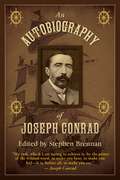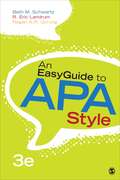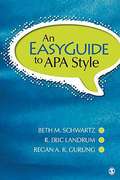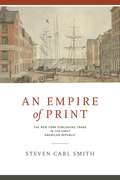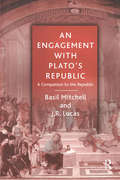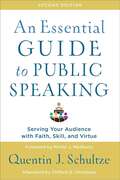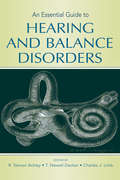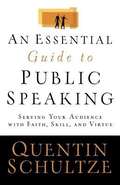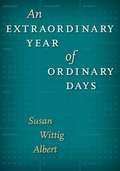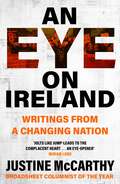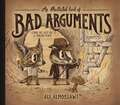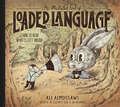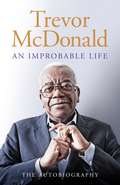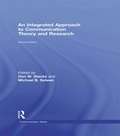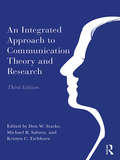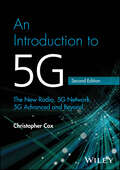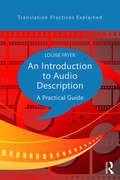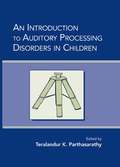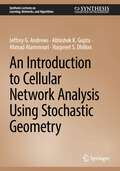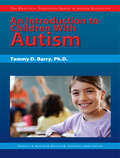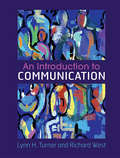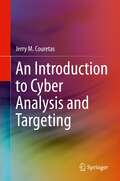- Table View
- List View
An Autobiography of Joseph Conrad
by Stephen BrennanHeart of Darkness author Joseph Conrad (born Józef Teodor Konrad Korzeniowski in 1857) was a Polish writer who learned to read, write, and speak English after he was granted British nationality in 1886. Although his peers accepted him as a British gentleman, he never forgot where he came from. In fact, the history of his native land of Poland often inspired the short stories and novels he penned. Those details, along with the experience he'd had since moving to Great Britain, found their way into many of his published works.In An Autobiography of Joseph Conrad, editor Stephen Brennan has selected pieces from some of Conrad's better known nonfiction works-including The Mirror of the Sea (1906) and A Personal Record (1912)-to showcase some of the more exciting and trying times in the novelist's life. Readers will attend school with Conrad in Russian Poland, sail with him in Marseille, and meet family members who took part in his upbringing, such as Uncle Tadeusz.Portraits of Conrad throughout the years, in addition to photos of his town, home, and family, supplement the text and help readers envision the author and his surroundings during various stages in his life.
An Easy Guide to APA Style
by Regan A. R. Gurung Beth M. Schwartz R. Eric LandrumWritten by experienced psychology instructors Beth M. Schwartz, R. Eric Landrum, and Regan A. R. Gurung, all active and respected members of the American Psychological Association (APA) Society for the Teaching of Psychology, the updated Third Edition of An Easy Guide to APA Style provides a reader-friendly guide for mastering APA style and covers all sections of an APA-style paper. Clear, conversational, and humorous, the book presents easy-to-understand explanations of how to write research papers, term papers, and lab reports, and cite references following APA style and format. The authors focus on the most essential elements of APA style and format, offering useful advice, tips, and visual representations.
An EasyGuide to APA Style
by Regan A. R. Gurung Beth M. Schwartz R. Eric LandrumDemystifying the process of writing in APA style and format, this handy guide presents precise examples (both writing examples and Microsoft Word screenshots) and points out common APA style and formatting mistakes and how to avoid them. Written in a conversational and clear style, this guide will help anyone find their way through the maze of rules in the APA Publication Manual and become proficient in learning the fine points of APA style. Key Features: - Offers guidelines and essential tips based on the sixth edition of the Publication Manual of the American Psychological Association (2009) - Explains the differences between writing in APA style and using APA format - Chapter Two, Your Visual Guide to APA Style, provides a "QuickFinder" for key issues and style points using a Sample Paper - Annotated paper and examples make it easy for readers to understand the nuances of AP?A style - A separate chapter on mistakes to avoid provides a quick and easy guide to common errors that people make when formatting their papers - A companion website with answers to the exercises in the book, additional exercises to further test your understanding of the format and style rules, additional study aids, updated information about APA format, links to other helpful web sites and resources
An Empire of Print: The New York Publishing Trade in the Early American Republic (Penn State Series in the History of the Book #28)
by Steven Carl SmithHome to the so-called big five publishers as well as hundreds of smaller presses, renowned literary agents, a vigorous arts scene, and an uncountable number of aspiring and established writers alike, New York City is widely perceived as the publishing capital of the United States and the world. This book traces the origins and early evolution of the city’s rise to literary preeminence. Through five case studies, Steven Carl Smith examines publishing in New York from the post–Revolutionary War period through the Jacksonian era. He discusses the gradual development of local, regional, and national distribution networks, assesses the economic relationships and shared social and cultural practices that connected printers, booksellers, and their customers, and explores the uncharacteristically modern approaches taken by the city’s preindustrial printers and distributors. If the cultural matrix of printed texts served as the primary legitimating vehicle for political debate and literary expression, Smith argues, then deeper understanding of the economic interests and political affiliations of the people who produced these texts gives necessary insight into the emergence of a major American industry. Those involved in New York’s book trade imagined for themselves, like their counterparts in other major seaport cities, a robust business that could satisfy the new nation’s desire for print, and many fulfilled their ambition by cultivating networks that crossed regional boundaries, delivering books to the masses.A fresh interpretation of the market economy in early America, An Empire of Print reveals how New York started on the road to becoming the publishing powerhouse it is today.
An Empire of Print: The New York Publishing Trade in the Early American Republic (Penn State Series in the History of the Book)
by Steven Carl SmithHome to the so-called big five publishers as well as hundreds of smaller presses, renowned literary agents, a vigorous arts scene, and an uncountable number of aspiring and established writers alike, New York City is widely perceived as the publishing capital of the United States and the world. This book traces the origins and early evolution of the city’s rise to literary preeminence.Through five case studies, Steven Carl Smith examines publishing in New York from the post–Revolutionary War period through the Jacksonian era. He discusses the gradual development of local, regional, and national distribution networks, assesses the economic relationships and shared social and cultural practices that connected printers, booksellers, and their customers, and explores the uncharacteristically modern approaches taken by the city’s preindustrial printers and distributors. If the cultural matrix of printed texts served as the primary legitimating vehicle for political debate and literary expression, Smith argues, then deeper understanding of the economic interests and political affiliations of the people who produced these texts gives necessary insight into the emergence of a major American industry. Those involved in New York’s book trade imagined for themselves, like their counterparts in other major seaport cities, a robust business that could satisfy the new nation’s desire for print, and many fulfilled their ambition by cultivating networks that crossed regional boundaries, delivering books to the masses.A fresh interpretation of the market economy in early America, An Empire of Print reveals how New York started on the road to becoming the publishing powerhouse it is today.
An Engagement with Plato's Republic: A Companion to the Republic
by Basil Mitchell J.R. LucasOutrageous, unfashionable, politically incorrect though many of Plato's opinions undoubtedly are, we should not just dismiss them as thoughts now unthinkable, but think through them, recognising the force of the arguments that led Plato to enunciate them and consider the counter-arguments he might have marshalled to meet contemporary objections. This book encourages today's students to engage in Plato's thought, grapple with Plato's arguments, and explore the relevance of his arguments in contemporary terms. A text only comes alive if we make it our own; Plato's great work The Republic, often reads as though it were addressing the problems of the day rather than those of ancient Athens. Treating The Republic as a whole and offering a comprehensive introduction to Plato's arguments, Mitchell and Lucas draw students into an exploration of the relevance of Plato's thought to our present ideas about politics, society and education, as well as the philosophy of mathematics, science and religion. The authors bring The Republic to life. The first chapters help the reader to make sense of the text, either in translation or the original Greek. Later chapters deal with the themes that Plato raises, treating Plato as a contemporary. Plato is inexhaustible: he speaks to many different people of different generations and from different backgrounds. The Republic is not just an ancient text: it never ceases to be relevant to contemporary concerns, and it demands fresh discussion in every age.
An Essential Guide To Public Speaking: Serving Your Audience With Faith, Skill, And Virtue
by Quentin J. SchultzeCommunication expert and popular speaker Quentin Schultze offers a practical, accessible, and inspiring guide to public speaking, showing readers how to serve their audiences with faith, skill, and virtue. This thoroughly rewritten and expanded four-color edition has been tested and revised with input from Christian undergraduates and contains new chapters on timely topics, such as speaking for video, conducting group presentations, and engaging society civilly. A complete public speaking textbook for Christian universities, it includes helpful sidebars, tips, and appendixes. Additional resources for students and professors are available through Textbook eSources.
An Essential Guide to Hearing and Balance Disorders
by R. Steven Ackley T. Newell Decker Charles J. LimbAn Essential Guide to Hearing and Balance Disorders consolidates the most significant clinical aspects of hearing and balance disorders, ranging from cause and diagnosis to treatment and cure. Experts in various subspecialties of this extensive topic introduce readers to the most sophisticated and state of the art methods of diagnosis and treatment. Each chapter expands on a specific topic area along the continuum of how medical personnel diagnose hearing and balance disorders, to how surgical implantation of the cochlea and rehabilitation can remedy various conditions. In concise format, the book begins with a case history and follows with comprehensive descriptions of current knowledge regarding fundamental causes of hearing loss and balance disorders, as well as a thorough examination of objective assessment. The latter half of the volume presents specialized treatment and rehabilitative options for various disorders. The chapters in this part cover special topics and conclude with pertinent case studies. Unique areas of discussion in a text of this kind include: genetics of deafness pediatric hearing loss and hearing loss later in life business essentials in audiology private practice professional issues, such as ethics, methods of practice, and conflicts of interest. As its title implies, this book is critically important for all students and professionals in hearing/balance related disciplines, including audiology, otolaryngology, general medicine, and rehabilitation oriented allied health care occupations.
An Essential Guide to Public Speaking: Serving Your Audience with Faith, Skill, and Virtue
by Quentin SchultzeWhether at a business meeting, church gathering, or social function, most of us will be called upon at some time to speak publicly. As Christians, we are called to speak not only with effectiveness but also in a way that honors God and embodies Christian virtue. In An Essential Guide to Public Speaking, communications expert Quentin Schultze encourages readers to become servant speakers who faithfully serve their audiences as neighbours. Besides providing a biblical perspective on public speaking, this accessible book also covers such practical topics as overcoming common challenges, the importance of listening, and the art of preparing and delivering well-crafted speeches. Filled with helpful sidebars, checklists, and tips, this is a book for any person who wishes to improve his or her public speaking skills.
An Extraordinary Year Of Ordinary Days
by Susan Wittig AlbertFrom Eudora Welty's memoir of childhood to May Sarton's reflections on her seventieth year, writers' journals offer an irresistible opportunity to join a creative thinker in musing on the events-whether in daily life or on a global scale-that shape our lives. In An Extraordinary Year of Ordinary Days, best-selling mystery novelist Susan Wittig Albert invites us to revisit one of the most tumultuous years in recent memory, 2008, through the lens of 365 ordinary days in which her reading, writing, and thinking about issues in the wider world-from wars and economic recession to climate change-caused her to reconsider and reshape daily practices in her personal life. Albert's journal provides an engaging account of how the business of being a successful working writer blends with her rural life in the Texas Hill Country and the Sangre de Cristo Mountains of New Mexico. As her eclectic daily reading ranges across topics from economics, food production, and oil and energy policy to poetry, place, and the writing life, Albert becomes increasingly concerned about the natural world and the threats facing it, especially climate change and resource depletion. Asking herself, "What does it mean? And what ought I do about it?", she determines practical steps to take, such as growing more food in her garden, and also helps us as readers make sense of these issues and consider what our own responses might be.
An Eye on Ireland: A Journey Through Social Change - New and Selected Journalism
by Justine McCarthy'Jolts like jump-leads to the complacent heart ... an eye-opener. MIRIAM LORDFOR FOUR DECADES, JUSTINE MCCARTHY'S FEARLESS JOURNALISM AND COMMENTARY HAS HELD POWER TO ACCOUNT AS SHE, IN HER OWN WORDS, 'GREW UP ALONGSIDE MY COUNTRY'.The book opens with a long personal essay in which Justine recounts her early years as a fearful child who dreamed of being a writer, to cutting her teeth in the male-dominated newsrooms of the 1980s, where she faced down sexism and broke gender barriers in a determined career marked by excellence.From Mary Robinson making history as Ireland's first female president to a present-day RTÉ in crisis, over thirty years of stories are collected here. In her long career, Justine broke child sexual abuse scandals and reported from the frontline of the Northern Ireland Troubles; she documented political turmoil and charted the role of Ireland on the world stage. She followed the times the country let down its people, through its ailing health system, its legal system, the domination of the church, and its treatment of women.An Eye on Ireland maps a transformative era in Irish life towards a more progressive and just society, and onewoman's extraordinary career at the forefront of change.
An Eye on Ireland: A Journey Through Social Change - New and Selected Journalism
by Justine McCarthy'Jolts like jump-leads to the complacent heart ... an eye-opener. MIRIAM LORDFOR FOUR DECADES, JUSTINE MCCARTHY'S FEARLESS JOURNALISM AND COMMENTARY HAS HELD POWER TO ACCOUNT AS SHE, IN HER OWN WORDS, 'GREW UP ALONGSIDE MY COUNTRY'.The book opens with a long personal essay in which Justine recounts her early years as a fearful child who dreamed of being a writer, to cutting her teeth in the male-dominated newsrooms of the 1980s, where she faced down sexism and broke gender barriers in a determined career marked by excellence.From Mary Robinson making history as Ireland's first female president to a present-day RTÉ in crisis, over thirty years of stories are collected here. In her long career, Justine broke child sexual abuse scandals and reported from the frontline of the Northern Ireland Troubles; she documented political turmoil and charted the role of Ireland on the world stage. She followed the times the country let down its people, through its ailing health system, its legal system, the domination of the church, and its treatment of women.An Eye on Ireland maps a transformative era in Irish life towards a more progressive and just society, and onewoman's extraordinary career at the forefront of change.
An Illustrated Book of Bad Arguments: Learn The Lost Art Of Making Sense (Bad Arguments #0)
by Ali Almossawi“This short book makes you smarter than 99% of the population. . . . The concepts within it will increase your company’s ‘organizational intelligence.’. . . It’s more than just a must-read, it’s a ‘have-to-read-or-you’re-fired’ book.”—Geoffrey James, INC.com From the author of An Illustrated Book of Loaded Language, here’s the antidote to fuzzy thinking, with furry animals! Have you read (or stumbled into) one too many irrational online debates? Ali Almossawi certainly had, so he wrote An Illustrated Book of Bad Arguments! This handy guide is here to bring the internet age a much-needed dose of old-school logic (really old-school, a la Aristotle). Here are cogent explanations of the straw man fallacy, the slippery slope argument, the ad hominem attack, and other common attempts at reasoning that actually fall short—plus a beautifully drawn menagerie of animals who (adorably) commit every logical faux pas. Rabbit thinks a strange light in the sky must be a UFO because no one can prove otherwise (the appeal to ignorance). And Lion doesn’t believe that gas emissions harm the planet because, if that were true, he wouldn’t like the result (the argument from consequences). Once you learn to recognize these abuses of reason, they start to crop up everywhere from congressional debate to YouTube comments—which makes this geek-chic book a must for anyone in the habit of holding opinions.
An Illustrated Book of Loaded Language: Learn To Hear What's Left Unsaid (Bad Arguments #0)
by Ali Almossawi Alejandro Giraldo“This is a book for every thinking person, the perfect antidote to today’s culture wars.”—Hope Jahren The creators of An Illustrated Book of Bad Arguments return with this desperately timely guide to how words can trick us. Learn to “hear” hidden bias, slant, and spin—from an irresistible cast of woodland creatures! Public discourse? More like public discord. The battle cries of our culture wars are rife with “loaded language”—be it bias, slant, or spin. But listen closely, or you’ll miss what Ali Almossawi finds more frightening still: words that erase accountability, history, even identity through what they leave unsaid. Speaking as wise old Mr. Rabbit, Almossawi leads us through a dark forest of rhetoric—aided by Orwell, Baldwin, and a squee-worthy cast of wide-eyed woodland creatures. Here, passive voice can pardon wrongdoers, statistics may be a smokescreen, gaslighting entraps the downtrodden, and irrelevant adjectives cement stereotypes. Emperor Squirrel isn’t naked; he has a clothes-free sartorial style. Mouse’s roof becomes flattened (Elephant’s foot just happens to be there at the time). And when keen-eyed Owl claims a foreign shore, he seems to be overlooking someone . . . Fans of Almossawi’s An Illustrated Book of Bad Arguments couldn’t ask for a better primer on the less logical ways that words can trick us. It takes a long pair of ears to hear what’s left unsaid—but when you’re a rabbit in a badger world, listening makes all the difference.
An Improbable Life: The Autobiography
by Trevor McDonaldSir Trevor McDonald is an extraordinary man - and he has led an improbable life. Now in his 80th year, he is known and loved by people the world over for his humility, charm and natural ease. As a natural storyteller and communicator, he has few equals. In An Improbable Life, Sir Trevor recounts his personal experience of world events and interviews with globally famous - or notorious - figures. He has witnessed war and death and risked his own life to meet and talk with despots and liberators. We read about his first trip to South Africa, and obtaining the first British television interview with Nelson Mandela; his reflections on the Windrush generation; and experiencing Barack Obama's momentous inauguration as President of the USA. We are also present at his dramatic meetings with Saddam Hussein (the first and only one by a British television correspondent) and Muammar Gaddafi.Engaging, intimate and moving, this is the life story of an exceptional journalist and broadcaster who over decades has expertly revealed to us history in the making.
An Improper Profession: Women, Gender, and Journalism in Late Imperial Russia
by Barbara T. Norton Jehanne M. GheithJournalism has long been a major factor in defining the opinions of Russia's literate classes. Although women participated in nearly every aspect of the journalistic process during the nineteenth and early twentieth centuries, female editors, publishers, and writers have been consistently omitted from the history of journalism in Imperial Russia. An Improper Profession offers a more complete and accurate picture of this history by examining the work of these under-appreciated professionals and showing how their involvement helped to formulate public opinion. In this collection, contributors explore how early women journalists contributed to changing cultural understandings of women's roles, as well as how class and gender politics meshed in the work of particular individuals. They also examine how female journalists adapted to--or challenged--censorship as political structures in Russia shifted. Over the course of this volume, contributors discuss the attitudes of female Russian journalists toward socialism, Russian nationalism, anti-Semitism, women's rights, and suffrage. Covering the period from the early 1800s to 1917, this collection includes essays that draw from archival as well as published materials and that range from biography to literary and historical analysis of journalistic diaries. By disrupting conventional ideas about journalism and gender in late Imperial Russia, An Improper Profession should be of vital interest to scholars of women's history, journalism, and Russian history. Contributors. Linda Harriet Edmondson, June Pachuta Farris, Jehanne M Gheith, Adele Lindenmeyr, Carolyn Marks, Barbara T. Norton, Miranda Beaven Remnek, Christine Ruane, Rochelle Ruthchild, Mary Zirin
An Integrated Approach to Communication Theory and Research (2nd Edition)
by Don W. Stacks Michael B. SalwenThis volume provides an overview of communication study, offering theoretical coverage of the broad scope of communication study as well as integrating theory with research. To explicate the integration process, the chapter contributors -- experts in their respective areas -- offer samples in the form of hypothetical studies, published studies, or unpublished research, showing how theory and research are integrated in their particular fields. The book will appeal to graduate students and faculty members who want a thorough overview of not only the field, but also sample research stemming from its various component parts.
An Integrated Approach to Communication Theory and Research (Routledge Communication Series)
by Don W. Stacks Michael B. Salwen Kristen C. EichhornThis new edition provides a comprehensive overview of current theory and research written by the top theorists and researchers in each area. It has been updated to address the growing influence of technology, changing relationships, and several growing integrated approaches to communication and includes seven new chapters on: ■ Digital Media ■ Media Effects ■ Privacy ■ Dark Side ■ Applied Communication ■ Relational Communication ■ Instructional Communication ■ Communication and the Law The book continues to be essential reading for students and faculty who want a thorough overview of contemporary communication theory and research.
An Introduction to 5G: The New Radio, 5G Network, 5G Advanced and Beyond
by Christopher CoxA comprehensive and approachable introduction to 5G and 5G-Advanced Written by a noted expert on the subject, this Second Edition of An Introduction to 5G delivers a comprehensive, system-level guide to 5G and 5G-Advanced. Building on the foundations laid in the First Edition, the topics explored include the market and use cases for 5G-Advanced; the architectures of the next generation radio access network, open radio access networks and the 5G core; the principles of radio transmission, millimeter waves and MIMO antennas; the architecture and operation of the 5G New Radio; the implementation of network function services by means of HTTP/2; and the signaling procedures that govern the end-to-end operation of the system. This Second Edition has been thoroughly expanded and updated for 3GPP Release 18, to cover the new capabilities introduced under the name of 5G-Advanced. There are new chapters on: The foundations of 5G-Advanced, including non-terrestrial networks, multicast/broadcast services, wireless backhauling, unlicensed spectrum, and artificial intelligence and machine learningThe Internet of Things, including time-sensitive communications, non-public networks, edge computing, and massive machine-type communicationsDevice-to-device communications on the 5G sidelink, in support of vehicle, aircraft and proximity-based servicesThe new features being introduced in 3GPP Release 19, and the expected applications, technologies and performance capabilities of 6G An Introduction to 5G is written for engineering professionals in mobile telecommunications, for those in non-technical roles such as management, marketing and intellectual property, and for students. It requires no more than a basic understanding of mobile communications, and includes detailed references to the underlying 3GPP specifications for 5G. The book’s approach provides a comprehensive, end-to-end overview of the 5G standard, which enables readers to move on with confidence to the more specialized texts and to the specifications themselves.
An Introduction to Audio Description: A practical guide (Translation Practices Explained)
by Louise FryerAn Introduction to Audio Description is the first comprehensive, user-friendly student guide to the theory and practice of audio description, or media narration, providing readers with the skills needed for the effective translation of images into words for the blind and partially-sighted. A wide range of examples – from film to multimedia events and touch tours in theatre, along with comments throughout from audio description users, serve to illustrate the following key themes: the history of audio description the audience the legal background how to write, prepare and deliver a script. Covering the key genres of audio description and supplemented with exercises and discussion points throughout, this is the essential textbook for all students and translators involved in the practice of audio description. Accompanying film clips are also available at: https://www.routledge.com/products/9781138848177 and on the Routledge Translation Studies Portal: http://cw.routledge.com/textbooks/translationstudies/.
An Introduction to Auditory Processing Disorders in Children
by Teralandur K. ParthasarathyAuditory processing in children (APD) comprises an increasingly important clinical area within the broad field of communication disorders. This new textbook presents the major advances in the assessment and management of APD. The chapter authors, highly regarded clinicians and researchers from diverse professional groups, contribute an impressive breadth of knowledge to explain and demystify APD. This text will be useful to students of speech language pathology and audiology, as well as professionals in those fields.
An Introduction to Cellular Network Analysis Using Stochastic Geometry (Synthesis Lectures on Learning, Networks, and Algorithms)
by Harpreet S. Dhillon Jeffrey G. Andrews Abhishek K. Gupta Ahmad AlammouriThis book provides an accessible yet rigorous first reference for readers interested in learning how to model and analyze cellular network performance using stochastic geometry. In addition to the canonical downlink and uplink settings, analyses of heterogeneous cellular networks and dense cellular networks are also included. For each of these settings, the focus is on the calculation of coverage probability, which gives the complementary cumulative distribution function (ccdf) of signal-to-interference-and-noise ratio (SINR) and is the complement of the outage probability. Using this, other key performance metrics, such as the area spectral efficiency, are also derived. These metrics are especially useful in understanding the effect of densification on network performance. In order to make this a truly self-contained reference, all the required background material from stochastic geometry is introduced in a coherent and digestible manner.This Book:Provides an approachable introduction to the analysis of cellular networks and illuminates key system dependenciesFeatures an approach based on stochastic geometry as applied to cellular networks including both downlink and uplinkFocuses on the statistical distribution of signal-to-interference-and-noise ratio (SINR) and related metrics
An Introduction to Children With Autism
by Tammy D. BarryThis new series offers timesaving books on critical topics for educating students with autism spectrum disorders. The four books in this series are filled with practical information and advice, thus making them an ideal resource for classroom teachers, preservice teachers, and graduate students. This introductory text in the series provides an overview of the characteristics of children with autism, the symptoms associated with autism, and the general nature of autism. An explanation of the autism spectrum and the culture of autism also are presented.
An Introduction to Communication
by Richard West Lynn H. TurnerPrioritizing brevity and clarity, this textbook introduces the study of communication through examples and applications of communication in a variety of contexts. With a unique focus on diversity and the impact of culture, each chapter opens with a case study that identifies a communication challenge, which the chapter addresses throughout, and concludes with questions that respond to that challenge. A consistent, organized structure with numerous features including fundamental issues, questions for understanding and analysis, theoretical insight (examining a particular relevant theory), and a skill set section, easily guides you through the foundations of the study of communication. Cross-referencing between chapters demonstrates the multidimensional nature of communication and the everyday talk sections demonstrate how each topic relates to technology, the workplace, or health issues. Offering a wealth of diverse examples from students' personal, professional, and online lives, this book teaches skills allowing students from all academic backgrounds to understand communication.
An Introduction to Cyber Analysis and Targeting
by Jerry M. CouretasThis book provides a comprehensive view of cyber operations, analysis and targeting, including operational examples viewed through a lens of conceptual models available in current technical and policy literature. Readers will gain a better understanding of how the current cyber environment developed, as well as how to describe it for future defense. The author describes cyber analysis first as a conceptual model, based on well-known operations that span from media to suspected critical infrastructure threats. He then treats the topic as an analytical problem, approached through subject matter interviews, case studies and modeled examples that provide the reader with a framework for the problem, developing metrics and proposing realistic courses of action. Provides first book to offer comprehensive coverage of cyber operations, analysis and targeting;Pulls together the various threads that make up current cyber issues, including information operations to confidentiality, integrity and availability attacks;Uses a graphical, model based, approach to describe as a coherent whole the development of cyber operations policy and leverage frameworks;Provides a method for contextualizing and understanding cyber operations.
